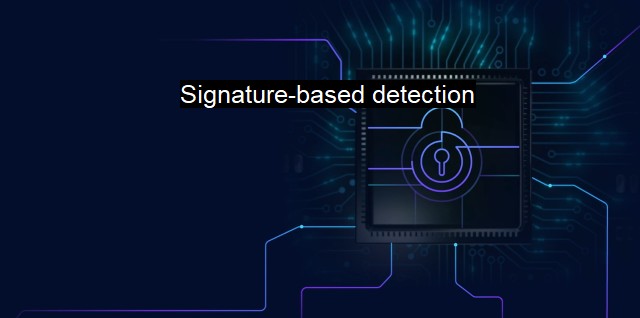What is Signature-based detection?
The Importance of Signature-Based Detection in Cybersecurity: Exploring How It Works and Its Significance for Businesses
Signature-based detection is a conventional methodology used extensively in cyber security systems to protect computers and networks from harmful cyber threats. This detection technique forms the foundation for most antivirus software solutions. It is effective in identifying and counterferring known malware threats, hence ensuring optimal protection against such threats majority of the time.Signature-based detection is predicated on the premise that any malware or malicious software exhibits particular identifiable characteristics termed ‘signatures,’ which are unique to that specific malware. These signatures vary from specific pieces of code, particular behavioral patterns to certain trends in data transmission.
When antivirus software scans a system using this methodology, it identifies threats by scanning and cross-referencing these unique signatures against massive databases that carry an extensive repertoire of known malware signatures. The databases are regularly updated to synchronize with the ever-evolving landscape of cyber threats. If the antivirus detects a file or piece of code with a signature that matches one from its database, it tags it as a threat and takes appropriate actions such as deleting it, denying it access, or quarantining it.
Signature-based detection is particularly effective with known threats because the method has a high detection rate for such threats. It's incredibly efficient at safeguarding against malware strains that have already been identified, studied, and documented. It significantly reduces the system's vulnerability window given the consistent adoption of methodologies to counter recognized threats.
This method struggles with zero-day threats that aren’t yet in any databases – malware that hackers have recently developed and introduced. Since the signatures of these novel threats are yet unknown, signature-based detection often overlooks them, thereby giving them free reign to the system without detection. This inability to tackle unknown threats is, perhaps, the most significant limitation of this detection, increasing the reliance on other malware detection methods.
Despite this critical shortcoming, the extensive use of signature-based detection isn't indiscriminate. It's used in conjunction with heuristic-based detection (a technique striving to determine possible threats by analyzing a program’s behavior rather than its code examination) to widen the range of detectable threats. The blend between heuristic and signature-based detection methods equips the cyber security software with a more robust defense system competent enough to identify older, known threats and newly-introduced, unknown malware.
There are also proactive measures used to enhance the capabilities of antivirus software and add an extra layer of security. The hybrid systems apply both signature-based detection - identifying known malware, and behavior-based detection – assisting in detecting unknown threats by examining the unusual pattern, thus advancing the overall efficiency and security features.
With significant advancements in artificial intelligence and machine learning, there is a consistent pursuit in the cybersecurity landscape for improving traditional techniques such as signature-based detection. Recently, there have been successful incorporations of machine learning algorithms to enhance the classification and identification processes, making it possible to identify malware before actually operating it.
Signature-based detection offers vital service in the cybersecurity sphere. Despite the limitations, it’s an essential part of almost any antivirus software as it provides a base level of essential security protecting against known threats. its efficiency is vastly improved when paired with more advanced threat-detection systems and AI capabilities, thereby providing comprehensive defense measures against both known and unknown cyber threats. Hence, the importance of signature-based detection cannot be undermined in the contemporary cybersecurity sector.

Signature-based detection FAQs
What is signature-based detection in cybersecurity?
Signature-based detection is a method used by antivirus software to identify and block malware based on known patterns or signatures. It compares files or programs against a database of known malicious signatures, and if a match is found, the antivirus software takes action to prevent or remove the file.How effective is signature-based detection?
Signature-based detection is effective against known malware and can quickly identify and block threats that match a known signature. However, it is not effective against new, unknown or zero-day threats, which do not have a known signature in the database.What are the limitations of signature-based detection?
The main limitation of signature-based detection is that it relies on having an up-to-date database of known signatures. If the antivirus software does not have the latest signatures, it may not be able to detect new threats. Additionally, some malware can evade signature-based detection by using advanced techniques such as polymorphism, which changes the signature of the malware each time it infects a new system.What are the alternatives to signature-based detection?
Behavior-based detection and machine learning-based detection are popular alternatives to signature-based detection. Behavior-based detection looks for suspicious behavior in programs or files, while machine learning-based detection uses algorithms to detect patterns in data and identify potential threats. These techniques are especially effective against unknown or zero-day threats, which do not have known signatures.| | A | | | B | | | C | | | D | | | E | | | F | | | G | | | H | | | I | | | J | | | K | | | L | | | M | |
| | N | | | O | | | P | | | Q | | | R | | | S | | | T | | | U | | | V | | | W | | | X | | | Y | | | Z | |
| | 1 | | | 2 | | | 3 | | | 4 | | | 7 | | | 8 | | |||||||